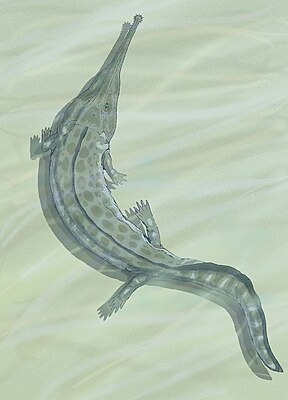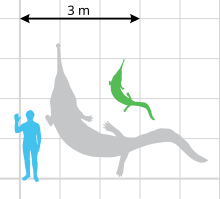Prionosuchus
| Prionosuchus | ||||||||||
|---|---|---|---|---|---|---|---|---|---|---|

Artistic reconstruction of a |
||||||||||
| Temporal occurrence | ||||||||||
| late Permian | ||||||||||
| Locations | ||||||||||
| Systematics | ||||||||||
|
||||||||||
| Scientific name | ||||||||||
| Prionosuchus | ||||||||||
| Price , 1948 | ||||||||||
Prionosuchus was a primitive land vertebrate from the group of Temnospondyles . Heavily fragmentedlate Permian fossil remainshave been found in the Pedra do Fogo Formation in northeastern Brazil . There is only one valid species, Prionosuchus plummeri . With an estimated length of nine meters, Prionosuchus is the largest amphibian ever to live on earth.
features
Prionosuchus was described in 1948 on the basis of a snout fragment, a partially preserved lower jaw and a femur by the Brazilian paleontologist Llewellyn Price. The rostrum of the holotype has a length of 34.5 cm and above the interface between the incisive bone and maxilla cm, a height of 2.0 cm and a width of 2.3. Behind this seam, the rostrum becomes wider and wider, up to 3.1 cm at its base with a height of only 1.7 cm. Price estimated half a meter as the length of the entire skull, which with the long, narrow snout resembled that of the recent gharial . The snout tip, 35 mm wide, had large, the rest of the snout with medium-sized conical fangs. A pair of fangs lay on the palatine bone in front of the inner nostrils and the ploughshare behind the inner nostrils.
During an excavation in 1972, skull fragments, vertebrae, ribs, shoulder blades, cleithrum , collarbone, iliac bone , ischium and femur of a much larger specimen were found. The tip of the snout is 10 cm wide, while that of the holotype is only 3.5 cm wide. Thus, the skull length of the large specimen is estimated to be 1.6 meters. Like other, better known Archegosauridae such as Archegosaurus and Platyoposaurus , Prionosuchus likely had an elongated body and long tail but small limbs. The incompletely preserved thigh bone cannot have been longer than 13 cm with a maximum diameter of 1.5 cm. Compared to a five-meter-long gavial, the skull of which is 83 cm long, Prionosuchus could have reached a length of about nine meters and was thus significantly longer than Eogyrinus and Mastodonsaurus , the next largest amphibians.
Prionosuchus probably swam in the manner of crocodiles through undulating movements of the trunk and tail and fed on larger aquatic vertebrates. As with the Gavial, the narrow snout reduced the resistance of the water when snapping shut.
Systematics
Prionosuchus belongs to the group of Archegosauridae and, like the other genera of the family, has an elongated, narrow skull and adjoining tearbones and frontal bones , the diagnostic characteristics of Archegosauridae named by the American paleontologist Alfred Romer .
literature
- C. Barry Cox, P. Hutchinson: Fishes and amphibians from the late permian Pedra do Fogo Formation of Northern Brazil. Palaeontology, 1991, PDF
